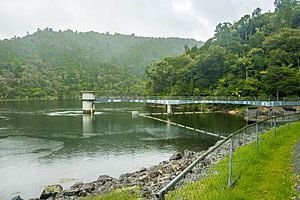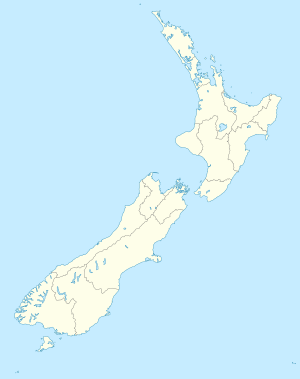Whau Valley facts for kids
Quick facts for kids
Whau Valley
|
|
|---|---|
|
Suburb
|
|

Whau Valley earth dam
|
|
| Country | New Zealand |
| Local authority | Whangārei |
| Electoral ward | Whangārei Urban Ward |
| Area | |
| • Land | 718 ha (1,774 acre) |
| Population
(June 2023)
|
|
| • Total | 2,920 |
| Postcode(s) |
0112
|
|
|
||
Whau Valley is a suburb located in Whangārei, a city in the Northland Region of New Zealand. It is a scenic area known for its valley and the important dam that supplies water to Whangārei. The valley was named after the 'whau' trees, which are native to New Zealand and grew there in the 1850s.
State Highway 1, a major road, runs through Whau Valley. At the end of Whau Valley Road, you'll find the main water supply for Whangārei City. This water comes from a large reservoir created by the Whau Valley Earth Dam. The reservoir is also a popular spot for fishing, as it is home to both rainbow and brown trout.
Contents
A Look at Whau Valley's Past
Whau Valley has a rich history, with some of the first European settlers arriving in the mid-1800s.
Early Settlers and Families
In 1859, William Hawken and his family were among the first to settle in the area, which was then called Whauwhau Valley. The following year, in 1860, John MacDonald and his family also arrived. The MacDonald family was part of a larger group of people from Nova Scotia who made their new home in the Whangārei area.
The Discovery of Coal
A significant event in Whau Valley's history was the discovery of coal on August 24, 1864. Henry Walton and William Grahame leased the land for 99 years and started a coal mine. To transport the coal, they built a wooden tramway. Horses pulled wagons of coal along this tramway to the Hātea River, where the coal could then be loaded onto ships.
Later, the tramway was replaced by a railway line. This new railway line between Kamo and Whangārei opened in March 1881. By 1885, the mine had produced a large amount of coal, about 45,359 long tons.
Who Lives in Whau Valley?
Whau Valley covers an area of about 7.18 square kilometers. As of 2023, it has an estimated population of 2,781 people. This means there are about 387 people living in each square kilometer.
Population Changes Over Time
The number of people living in Whau Valley has changed over the years:
- In 2006, there were 2,601 people.
- In 2013, the population was 2,538.
- By 2018, it had grown to 2,799 people.
- In the 2023 New Zealand census, the population was 2,781. This was a small decrease of 18 people since 2018, but an increase of 243 people since 2013.
A Diverse Community
In 2023, there were 1,353 males, 1,425 females, and 3 people of other genders living in 1,035 homes. The average age of residents was 42.5 years.
Whau Valley is home to people of many different backgrounds. People could choose more than one ethnicity in the census. The results showed that:
- 74.9% identified as European (also known as Pākehā).
- 28.4% identified as Māori.
- 4.3% identified as Pasifika.
- 8.3% identified as Asian.
- 1.3% identified as Middle Eastern, Latin American, and African New Zealanders (MELAA).
- 2.7% identified as other ethnicities, including those who said "New Zealander."
Schools in Whau Valley
Whau Valley has several schools, providing education for local children.
- Whau Valley School is a primary school for students in years 1 to 6. It has about 260 students.
- St Francis Xavier School is a Catholic primary school, also for years 1 to 6. It has about 210 students. This school is state integrated, meaning it's a private school that gets some government funding.
- Whangarei Adventist Christian School is a full primary school, teaching students from years 1 to 8. It has about 60 students. This school is also state integrated.
All these schools teach both boys and girls.


